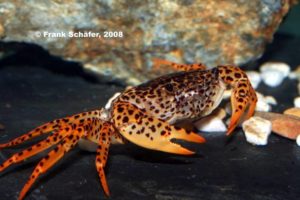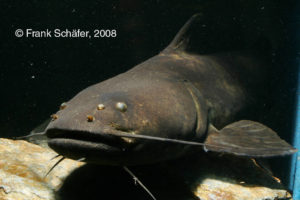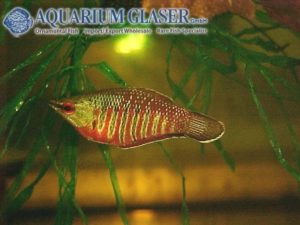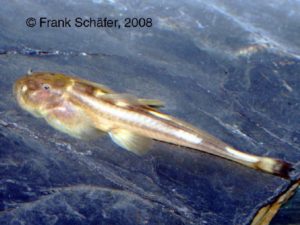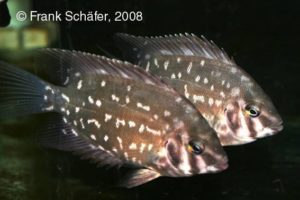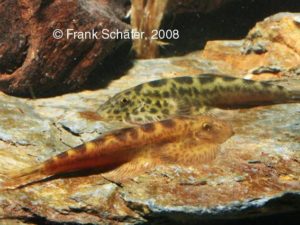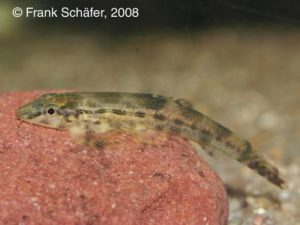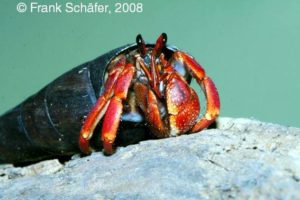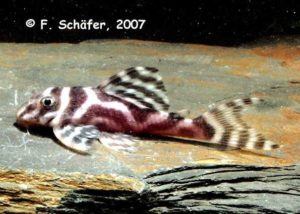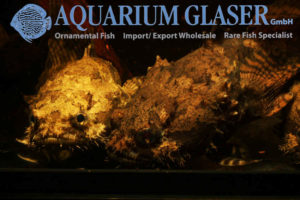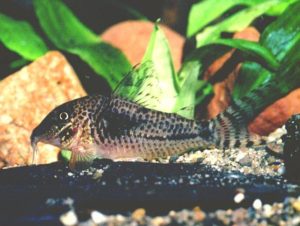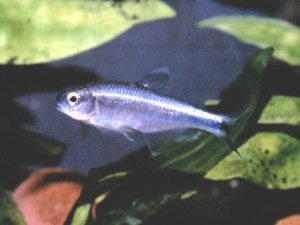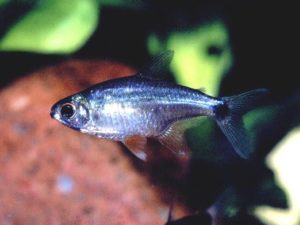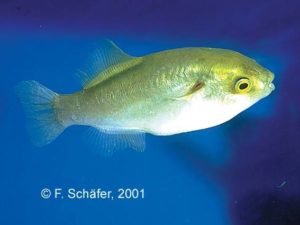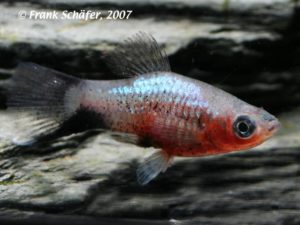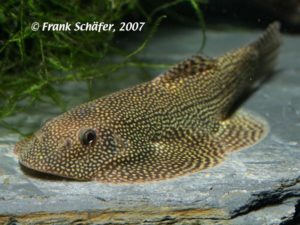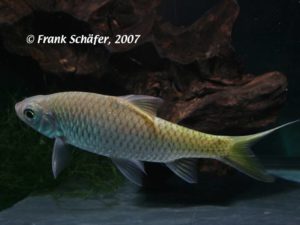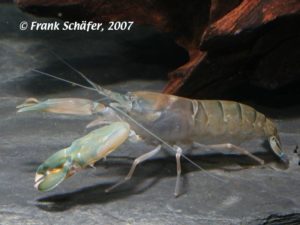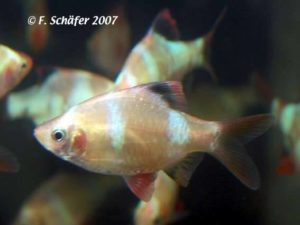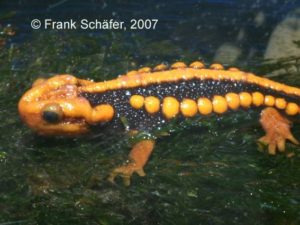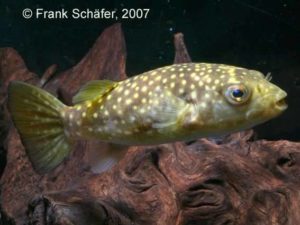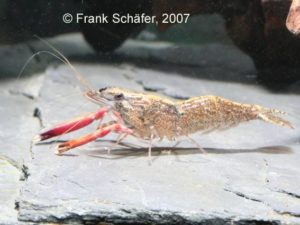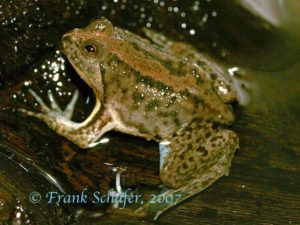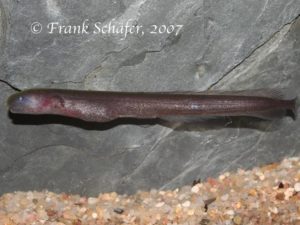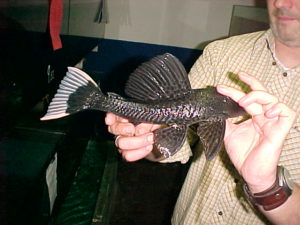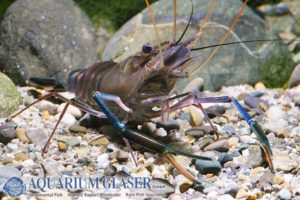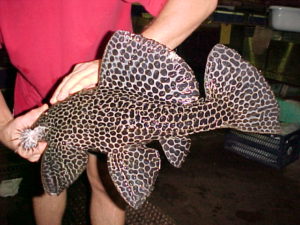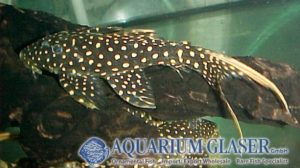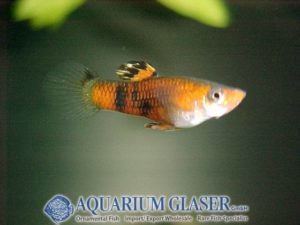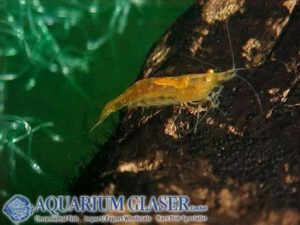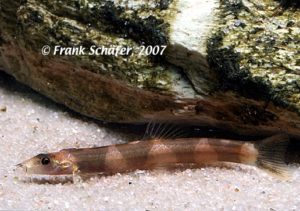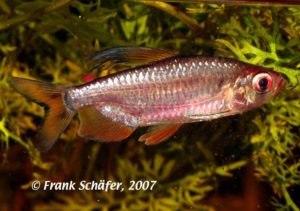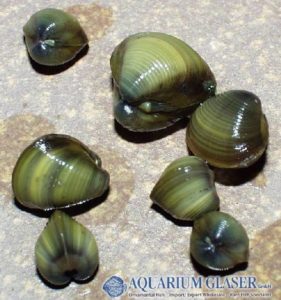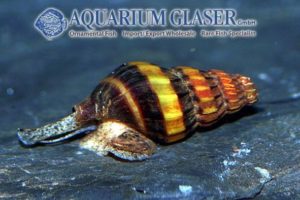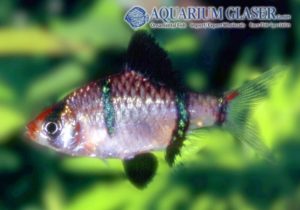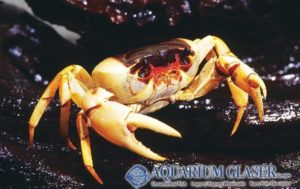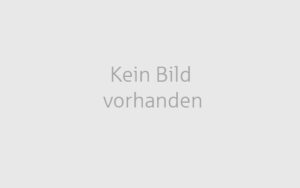The Ram is one of the most beautiful aquarium fishes. The wild Ram originates from the llanos of the Orinoco. The newest sport of this dwarf cichlids is blue all over the body. It is virtually impossible to illustrate this very special colour in a high resolution picture. Only reducing the resolution brings the effect […]
Fish Archive (3137)
-
-
Opsodoras stuebelii
The Doradidae family contains around 90 species in about 35 genera. Thus they represent only a minority among the huge number of catfishes existing in South America. But all dordadid catfishes are really bizzarre and desirable creatures for catfish enthusiasts. There are dordaid catfishes that reach around one metre in length, but for Opsodoras stuebelii […]
-
Astacus astacus
The Noble or River cray, Astacus astacus, is sadly in danger of extinction in central Europe. The reason for this are the extreme destruction of the natural habitats in combination with the introduction of a Northamerican species between 1860 and 1870. This species, the so-called Camber cray (Orconectes limosus) was infested with a disease. This […]
-
Hydrolycus scomberoides
The Dogtooth characins (Hydrolycus) are small genus of tetras (four species) that have a wide distribution in tropical South America. They have in common very long saber-like teeth in the lower jaw. In the upper jaw cave-like notches are present, as otherwise the fish would not be able to close the mouth. These saber-teeth are […]
-
Nannostomus anduzei
For the first time ever we were able to import this tiny fish in larger numbers. Until now the fish was available only by accidental by-catches. Please read more about this new jewel for nano tanks: Within the family Lebiasinidae, sixteen scientifically accepted species of the genus Nannostomus are known. Still, in aquatic specialist shops […]
-
Markiana nigripinnis
We were able to import one of the most unusual tetras again: Markiana nigripinnis. Our specimens originate from Argentina. The species inhabits the river basins of the Paraná, Paraguay and the Marmoré (Argentina, Bolivia, Brazil, Paraguay). Due to the southern subtropical region where the fish occurs it is not necessary to install a heater in […]
-
Geophagus dicrozoster and G. abalios
The beautiful eartheaters of the Geophagus-surinamensis relationship are among the most colorful cichlids, shining in all colours of the rainbow. There are numerous species and some of them even have colour varieties in different river systems. As these are currently not recognized by scientists, we help ourselves in adding the river´s name behind the scientific […]
-
Hypancistrus L236xx
The Brazilian species of the genus Hypancistrus are currently not allowed to be exported from the country. Thus L-numbers of this genus, like L236 from the Rio Iriri, are available as bred specimens only. Among the last brood we received was one extraordinary specimen, which is depicted here. Text & Photo: Frank Schäfer
-
Lepomis gibbosus
The pumpkinseed (Lepomis gibbosus) is one of the most beautiful coldwater fishes. Moreover it has a very interesting behaviour. The species originates from central parts of the North American continent. The continental climate (hot summers, cold winters) makes the pumkinseed a hardy fish and so it was transferred by humans to many regions as a […]
-
Wakin Hoe Kim
Goldfish are timeless classics. The number of different sports and colours seems to be neverending. Basicly all goldfish belong to the very same species, eg Carassius auratus. So every single sport is a mere variety and all the different goldfish can be crossed with each other. Most of the varieties that exist nowadays have a […]
-
Pygocentrus piraya
The „real“ piranha, Pygocentrus piraya, is restricted to the river system of the Sao Francisco in southern Brazil. It is a up to 30 cm long species, which is characterized by its deep red breast and the mighty jaws when it is fully grown.However, even juveniles display a very attractive coloration. Most piranha species belong […]
-
Available again: Pterobrycon myrnae, the Semaphore tetra
New stock arrived for first calendar week 2010 And the good news is: the are considerably more favourable than last year! It was only twice, 1998 and 2008, that we received the Semaphore Tetra by Thomas Schulz. This fish is restricted to fast running brooks in Costa Rica. It is a spectacular tetra and luckily […]
-
A new pleco from the Rio Sao Francisco
The Rio Sao Francisco is a large river in southern Brazil. It´s length is around 3.200 km. The ichthyofauna of the Sao Francisco is comparably good explored, as there plans for an irrigation project. So the environment has to be explored and there were and are several studies on the fish fauna. We currently received […]
-
Land hermits: Coenobita rugosus imported!
From Taiwan we were able to import beautiful land hermits. They belong to the species Coenobita rugosus, which can be recognized by the ridge-like swellings on the upper edges of the claws. The colour is very variable and can be grey, brown or reddish. Like all Coenobita species the animal likes to live in groups. […]
-
Potamotrygon cf. falkneri
Currently we have a great selection of wonderful river stingrays from Paraguay belonging to that species in stock. As in all river stingray species, each individual has its own colour pattern, which differs clearly from all other congeneers. This is one of the reasons why species can only be distinguished with great difficulties in Potamotrygon. […]
-
Just in: L114
After some time we were able now to import again L114. It is a member of the beautiful Pseudacanthicus-leopardus species group. The members of this species group can reach 25-30 cm total length, some sources give even 40 cm. They originate from the Rio Negro basin near Barcelos in Brazil. They are omnivorous, but prefer […]
-
Ctenopoma acutirostre Leopard babies!
Among the most beautiful anabantoids or labyrinth fish from Africa is Ctenopoma acutirostre, the Leopard bushfish. It can become 15-20 cm long. Its natural habitat is the Congo. It is collected there for the ornamental fish trade in the Stanley Pool region. Here the fish live under the swimming meadows of the water hyacinth (Eichhornia […]
-
Trichomycterus alternatus: In the shadow of the vampire
female Sometimes fishes have the same problems as human beings: one cannot choose his relatives! And so the good reputation of a small fish sometimes is destroyed due to the bad one of a cousin. The most by far feared species of fish in South America is the so-called candiru. In fact, the name candiru […]
-
Neocaridina Deep Blue Tiger Yellow Eyes
The latest new entry in our stocklist: this is a very beautiful sport of the tiger shrimp. The blue sport is known for quite a long time. Our new stock shows extreme bright colours. Males can grow to a size of 2.5 cm, females become 3.5 cm long. For our customers: the animals have the […]
-
Neocaridina Red-Bee-Snow-White-Shrimp
Breeding of „Crystal Red“ shrimps has become a widespread hobby. These dwarf shrimps are real pets in the sense of domesticated animals, a very interesting fact under the aspect of culture history: this is the first case of a crustacean that has been cultivated for that reason since the rise of men on earth! A […]
-
Hyphessobrycon amapaensis
One of the most beautiful tetras of South America is availble now in brillantly colored wild collected specimens. The Amapa tetra is an uncomparable eye-catcher for any well suited community tank for South American fishes. As usual, among these wild collected fishes were also specimens of other species, so-called by-catches. This gives us a good […]
-
Bamboo shrimps actually spawned
Last week we could introduce to you the new Bamboo shrimp, which we imported for the first time ever from Taiwan. Due to the extreme high price of the two alleged pairs we established them not in the fish house, but in our show room. Yesterday a scientist researching on these shrimps asked us about […]
-
Protomyzon pachychilus
For the first time we were able to import these charming hillstream loaches. Due to their origin (China) and their black&white coloration we call them dwarf panda hillstream loaches. Although the species has been scientifically described back in 1980 in a Chinese journal almost nothing has been published concerning the beautiful animal since then. Our […]
-
Sensation: Bamboo shrimp from Taiwan
We are proud and happy that we were able to import yesterday the first few pairs of a new shrimp from Taiwan. According to the local scientists it belongs to a so far undescribed species. There is no doubt that it belongs to the Atya-relatives. The males of the „Bamboo shrimp“ are almost two times as […]
-
Wonderful German bred Zonancistrus pulcher (L168) arrived!
Photo: Frank Schäfer
-
Eretmodus cyanostictus “Makombe”
Actually we can offer very pretty Tanganyika Clowns, Eretmodus cyanostictus, from Makombe. Like so many other cichlids from the lake they have developed a lot of different geographical varieties. Eretmodus are highly specialized fishes. In the wild they live in the very shallow water of the shore. Here, in the surf, they feed on aufwuchs. […]
-
Great variety of freshwater stingrays available at Aquarium Glaser
The export stop of freshwater stingrays (Potamotrygon) has ended and so the very much sought after black species (P. henlei and P. leopoldi) are regulary available now again. Beside these Brazilian black rays we have astonishing Flower rays (P. schroederi) from Colombia and Venezuela, fantastic „King Marble”and Fire Spot” from Colombia (called P. motoro in […]
-
Schistura cf. jarutanini
The brook loaches of the genus Schistura are far spread over South and Southeast Asia. There are hundreds of species, most of them still scientifically undescribed. Almost each flowing water has it´s own species. So it is no surprise that some of the species also became cave-dwellers. We could import a small number of individuals […]
-
Import season for Orinoco-Plecos has startet!
The Rio Orinoco is with more than 2.000 km length one of the biggest rivers of South America. About 3/4 of it´s length it runs through Venezuela, the remaining 1/4 belong to the territory of Colombia. The Brazo Casiquiare connects during high water levels the Orinoco-sytem with the Amazon-sytem via the Rio Negro. The import […]
-
Pyrrhulina laeta
It is quite long ago that we were able to import this wonderful tetra. But now we can offer it again! Including the caudal fin the males can reach 12 cm in length. Males are generally larger than the females. A characteristical pattern for the species is the black line that extends to the level […]
-
Toxotes jaculatrix
Seven species of Archerfishes (Toxotes) are known. Three of them (T. lorentzi and T. kimberleyensis from Australia and T. microlepis from South East Asia) are usually found in fresh water. Two are practically unknown, at least they have not been kept in aquaria so far: T. blythi from Burma and T. oligolepis from the Moluccas. […]
-
Betta splendens
We have a new supplier for fighting fish (Betta splendens). Besides the amazing males (which we will introduce to you detailed in the near future) there are also wonderful females. Text & Fotos: Frank Schäfer
-
The Odessa barb has finally been named: Pethia padamya
There is a good number of well known aquarium fish that bear no scientific name, so they „officially” do not exist at all! Only with a formal scientific description a name can be applied to a species that is binding for every person in the world. On the other hand, common names can be given […]
-
Chilodus gracilis
There are four species of the small headstanders of the genus Chilodus. Only two of them appear in the hobby. According to reports the Spotted Headstander (Chilodus punctatus) is the most common species in the hobby. But, in fact, it is not. The species found most is Chilodus gracilis which can be distinguished from […]
-
Brachyplatystoma
The catfishes of the genus Brachyplatystoma are some of the most important foodfish in the basins of the Amazon, the Orinoco and the countries of the Guiana shield. Some of them may reach a length of 360 cm and a weight of 200 kg. Many thousand tons are landed each year, which led to local […]
-
A great number of Leporinus species in stock
Actually, Aquarium Glaser has many Leporinus species in stock. These are often very attractively coloured large tetras which are perfectly suited for large and show aquaria. Text & Photos: Frank Schäfer
-
Danio tinwini ( = sp. Panther)
UPDATE: This species has been scientifically described as Danio tinwini, see: Kullander, S. O. & F. Fang (2009): Danio tinwini, a new species of spotted danio from northern Myanmar (Teleostei: Cyprinidae). Ichthyological Exploration of Freshwaters v. 20 (no. 3): 223-228. The smallest species of Danio known so far was now imported by Aquarium Glaser after […]
-
Pearlscale
The goldfish is the eldest ornamental fish species in the world. For hundreds of years it has been bred on highest levels. Although the western aquarium hobby is unthinkable without the goldfish and its varieties the main breeding centres are still located in the east of Asia. It is very important to know where a […]
-
Barbus erythromycter – Lipstick barb
The males of this unique dwarf barb (maximum size around 4 cm) have a red “walrus moustache”. Until the scientific description of the species in 2008 it was known in the trade as Barbus cf. puntio. Text & Photos: Frank Schäfer
-
Baryancistrus L18, L81, L81n, L177
The main collecting season of the beautiful gold seam sucker cats of the genus Baryancistrus starts around end of may and lasts until the end of september. Although these fishes are common in the wild, live in shallow waters and are traditionally used as food fish, they cannot be connected with one of the about […]
-
Pterophyllum scalare Blue Dwarf
In 1949 Werner Ladiges mentions a blue dwarf angel (Pterophyllum scalare) that appeared by chance (problably by mutation) in a large breeding stock before WW2. Beside its unique blue coloration a characteristicly feature of these fishes was their small adult size. They never grew bigger than 5 cm body height. Although this stock survived WW2 […]
-
Boehlkea fredcochui now Knodus borki
Dr. Axel Zarske found that the species imported for decades under the name Boehlkea fredcochui in truth represented a species of the genus Knodus so far unknown to science. The real Boehlkea fredcochui was now and then imported under the trade name Boehlkea sp. Sky Blue. So our good old aquarium fish is now named […]
-
Auchenipterus nigripinnis
For the first time ever we were able now to import a catfish from Argentina which is new for the hobby. It looks amazingly similar to the Asian shark, Pangasianodon hypophthalmus (a well known synonym of that species is Pangasius sutchi). The identification of the new fish wasn´t easy, but thanks to Ingo Seidel from […]
-
Telmatherina bonti
The Malili lake system on Sulawesi (former Celebes) is home of spectacular shrimps, snails and mussels which are exported for the hobby. Now the import of an endemic atherinoid species was successful, namely Telmatherina bonti. Like many atherinoides of the Malili lakes this species is polychromatic, which means that males and females appear in different […]
-
Limnopilos naiyanetri
Described in 1991, Limnopilos naiyanetri Chaung & Ng, has only just been discovered by the hobby. Crabs are found in pure freshwater in the roots of floating vegetation, ie. water hyacinth (Eichornia crassipes) and fine-leaved aquatic plants along the riparian zone (river banks). They have hairy bodies and appendages which collect mud and dirt and […]
-
Corydoras sp. „Uruara“ CW037
(Nov.13th 2008) This beautiful Corydoras is from Brasil, from Rio Uruara , which flows into Rio Curua Una south of the Amazonas to be exact. It was imported to Germany only in very small numbers. The more pleasant it is that bred ones are available for the first time. The catfish recall very much of […]
-
Hyphessobrycon pyrrhonotus Gold
(Nov.10th 2008) The so called „gold dust disease“ of the bloodfins is a very interesting phenomenon, which happens to very many bloodfin species. The best known one surely is the gold-tetra, Hemigrammus rodwayi whose number of gold-dust-sick animals in nature is higher than of the normal coloured ones. The gold-dust-sick animals were even considered as […]
-
Acantopsis sp.
(Nov.6th 2008)Due to its unusual head shape the horseface loach A. coirorhynchos is one of the most popular aquarium fish. In nature they often are residents of clear rivers, where you can find them especially on sandy grounds. Inside the aquarium you also have to provide sandy ground, which allows them to completely bury themselves. […]
-
L90 Panaque var.JUANJUI
Last week this very attractive variant of L 90 arrived from the vicinity of Juanjui (Peru). They are very intense light-dark patterned fishes with glowing red eyes . The white filaments of their caudal fin give them an additional elegance. Feeding with special food (shrimps, or red discus food)can change fin colors to a strong […]
-
New Guppies available!
From now in limited numbers available: beautiful strains of Guppies! Please note that you will get for all the strains the correct females.
-
Ptychochromis oligacanthus
They come from the crater lake Bempazawa on the island Nosy Be nearby Madagascar and we have few of them available for first time: Ptychochromis oligacanthus “Bempazawa”. Their final length is more than 20 cm, but with their current size of about 15cm, they already reached sexually maturity. They have no special demands for food […]
-
Herichthys sp. BLUE-GALAXY
(Aug.6th 2008) A brand new star is born: Herichthys sp. Blue-Galaxy. We are proud to be able to supply limited numbers of this this beautiful breeding form for the first time. They are pubescent in a size of 6-8cm, which they have successfully demonstrated in a tank in our office. Since they should not get […]
-
Impressions of our shipment from Argentinia on July 29th 2008
-
Stiphodon semoni
(23.Aug.2008) From Indonesia we received this beautiful neon-blue goby. Stiphodon semoni grows up to 4-5cm and was several times imported under the wrong name Sthiphodon elegans. Its habitats are fast floating hillstreams with rocky ground. It is found in Indonesia, the Philippines, New Guniea and the Solomon Islands. The nourishment for this item is easy: […]
-
Synodontis granulosus
(June 6th 2008) Actually we are able to supply one of the most beautiful member of the Synodontis family. They come from the Lake Tanganjika so they need harder water with a higher pH. These are extremely active fishes which grow up to 25cm, so they should only be kept in bigger tanks. Adults are aggressive […]
-
3500gramm & 35cm: Serrasalmus rhombeus BLACK
They have this amazing size, the Black Piranhas we received last week from Peru.We got a group of 3 pieces in 3 big double-boxes….and all arrived in a perfect condition.They are really beautiful: very graceful but also really verythreatening. Very fascinating!
-
Parathelphusa pantherina
(21.Mai 2008) Last week we received from the Matano Lake in Indonesia a very beautiful crab: the panthercrab. Since they live nearly totally under water, they need only a small terrestrial part in their tank. A hard water with a temperature from 25-29°C is favored. They can be easily fed with all kind of foods; […]
-
Glanidium melanopterum
(09.May 2008) A real strange fish was now imported by us from the south of Brasil. This fish belongs to the Glanidium family and shows a size of about 40cm, which is really big for such an fish. They look very calm, but during the night they start to eat….everything what they can get into their big […]
-
Sphaerichthys vaillanti
(25.April 2008) A real beauty made by nature is currently available: Sphaerichthys vaillanti. This fish, which is called red chocolate gourami, is without any doubt the best looking one of all 4 Sphaerichthys members. The water should be soft, not too cold (25-29°C) with a low pH (4,5-6,5). If you offer these water parameters, you […]
-
Oreoglanis siamensis
(21.April 2008)…and again we got something very rare: Oreoglanis siamensis. But only a very few pieces. They live in the Mekong area and the Chao Phyraya basins. In the northern part of Thailand you can find them in the mountain area of Mae Nam Ping and Doi Chiang Dow. They are found in fast floating […]
-
Uaru fernandezyepezi
(9.April 2008)For the first time we can offer some offspring of Uaru fernandezyepezi. The home of this extremely rare cichlid is in the border area of Colombia and Venezuela, where they occur in the area of the Rio Atabapo. From there origin some challenging fishes such the Altum-Angels. Their requirements are similar, the water hardness […]
-
Crenicichla sp.ATABAPO FIRE Venezuela
Last week we got a very small amount of one of the most beautiful pikecichlids: Crenicichla sp.ATABAPO FIRE Venezuela. Sorry for the bad picture, but it was taken directly in a tank in our facility, not in a photo-tank. But it shows how nice this fish is!
-
Sinogastromyzon wui
(18. Feb.2008) Last week we received this loach which was described by FANG 1930. Their habitat is from the Nanpan-jiang and Xi-jiang basins in Guangdong to Guanxi provinces in China. The maximum size is about 8-10cm. They should be kept in cold water, not over 22-23°C, and they have very high oxygen requirements. To offer […]
-
Homaloptera tweediei
(14.Feb.2008) The adult size of the gecko-loach, Homaloptera tweediei, is only approx. 4cm. This species is very interesting for the hobbyists, because they can be kept for a longer period in a water temperature of more than 24°C. The main reason is the origin in central Thailand. After acclimatisation they are very thankful and easy […]
-
Coenobita cf.pseudorugosus
(11.Feb.2008) Again a new “crawler”: Coenobita cf.pseudorugosus. From Asia we received this super red hermit crab. The conditions to keep them are similar to all other land hermit crabs. Noteworthy are the nice flats they carry: from screwdriver snails of 5-6cm which the hermit quit the leasing contract…because of own requirement….(Photo F.Schäfer, Text R.Neunkirchen)
-
Hypancistrus spec. L 173b
(19.Feb.2008) After a long break back in our stock: German offspring of L 173. This very rare Hypancistrus is probably the most closely with L 46 related species. As juveniles they look like zebras with an irregular stripe pattern. Their final size is a little larger than L 46 L also their clutches are larger. […]
-
Allenbatrachus grunniens
(01.Feb.2008) Toadfish – a funny name for a funny family, the Batrachoididae. There are only 73 representatives of this family worldwide. Their name is coming from noises which they can generate and sounds like the callings of toads. Toadfish have a venomously spine on the gills and their dorsal fin and when you catch them, […]
-
Corydoras sp. C 115/116
(16.Jan.2008) This Longnose armored catfish was caught by Hoffmann & Hoffmann in Peru in a small canyon 50km away from Puerto Maldonado toward Boliva in 2004 and brought along legally. The very variable drawing, from monochromatically grey to big black spots on the sides of body (hence C115 and 116) is interesting. The breeding is […]
-
Bryconamericus/Hemibrycon sp.
(16.Jan.2008) These beautiful, agile, steel-blue shining tetra, which grow up to approx. 6cm were caught by Hoffmann & Hoffmann in a clearwater stream in Peru nearby the Andes in 2004. Six animals reached Germany and could be bred. They do not need much warmth, 24°C are sufficient. The youngsters grow slowly. An exact classification was […]
-
Cheirodon sp. (A)
(16.Jan.2008) The most colourful type of the three different Cheirodon/Odontostilbe species caught by Hoffmann & Hoffmann in Peru in 2004, which cannot be classified exactly is Cheirodon sp. (A). The animals have red coloured belly- and anal fins, males more intense than females. Also these fish were already often bred. They are productive and fast-growing.(Photo […]
-
Auriglobus silus
(21.Dec.2007) Streched Puffer is his name. This week we recieved this frisky puffer from Thailand. They are easy to keep and do not need special water parameters. In bigger sizes they can tend to fight between themselves. All in all it is an interesting puffer, which will be kept mainly from experts or experienced hobbyists. […]
-
Platy BLEEDING HEART BLUE COMET
(19.Dec.2007) Also this new bred variety arrived here last week. Currently we only have a few pieces in stock, which are males only. The coloration “bleeding heart” – the deep red basic colour, which is only restricted to the below body half – can only appear at males for genetic reasons. The females cannot be […]
-
Sewellia sp. Spotted
(19.Dec.2007) This, very attractive, probably scientifically not described hillstream sucker reached us from Vietnam. They remember on Sewellia lineolata but their point pattern is finer and also is the for S. lineolata characteristic “stripe” missing. Like all hillstream suckers they come from fast flowing water, there they inhabit rapid flowing streams where they graze on […]
-
Poropuntius laoensis
(19.Dec.2007) For the first time Aquarium Glaser was able to import this barb, which is sized 20-25cm and which is quite unnoticeable at first sight. It usually residents in clear wood bourns in the catchment area of the huge Mekong River. The peaceful animals turn out to be very colourful, if you look closely. Especially […]
-
Alpheus cyanoteles
(17.Dec.2007) Pistolshrimp…that`s what they are called. Currently we have a very limited number in stock. Generally this is a brackish item, which is totally adapted to live in freshwater. They come from the peninsula of Malaysia. They can create a sound like the shoot of a pistol, which is why they are called Pistolshrimp. You […]
-
3 new varieties of Barbus tetrazona
Since last week we can supply 3 new breedingforms of the Tiger-Barb. They are called gold-green-stripe: albino-platinum: and green-platinum: From now we will have those on a regular base in stock.
-
Tylototriton shanjing
(13.Dec.2007) One of the most beautiful representative of the genus Tylototriton is available: T.shanjing. These beauties comes not on a regular base. Their habitat is the middle and western part of the chinese province Yunnan, Laos & Myanmar. They live in subtropical forests in an altitude of around 2000meters. The females lay up to 300 eggs […]
-
FIRST TIME IMPORTED: Arothron firmamentum
Just yesterday we got from Burma an marine pufferwhich was caught in pure freshwater: Arothron firmamentum. This is the first time that this item was found in freshwater and we hope that we can provide more details about them soon.
-
Macrobrachium sp.RED CLAW
This amazing shrimp arrived last week: Macrobrachium sp.RED CLAW. We received a very limited number of this item, which is coming from east Borneo. Our supplier told us that he never shipped them to Europe before. This picture is showing a male, if you click on the small blue fish next to the picture, you […]
-
Occidozyga lima
(30.Nov.2007) From now available on a regular base : Occidozyga lima, the floating frog. These funny guys come from Indonesia. They are easy to keep and should be kept in small groups of at least 10 pieces. They only grow up to 3-4cm and show no sexual dimorphism. They eat all kind of small flies like Drosophila, but […]
-
Isichthys henryi
(29.Nov.2007) Currently in stock: one of the rarest Mormyrids in the world: Isichthys henryi. Our supplier from Guinea informed us that this item appear only 2-4weeks per year! So it only can be called luck to have nearly one hundret pieces right now in stock! To keep the single is recommended, because they are agressive […]
-
Caridina cf. propinqua
30.Nov.2007) Now we are happy to have them available in big numbers : the mandarinshrimp, Caridina cf. propinqua. Yesterday we received a good quantity of this beautiful shrimp from our supplier . Their origin is the isle of Sulawesi. So far we can say are they easy to keep; the females grow up to 2cm […]
-
Hypostomus isbrueckeri
(28.Nov.2007)At the moment we have a group of nearly full-grown Hypostomus isbrueckeri in stock. The here pictured male is easily distinguishable from its partners by the bright colors of the caudal fin. This is probably the only Loricariid species which shows such a pronounced gender difference. Their origin is the border region Brazil, Argentina, and […]
-
Macrobrachium rosenbergii
(26.Nov.2007)The genus Macrobrachium rosenbergii is playing a very important role in the Aquaculture in many regions of asia. Mainly in Thailand they are bred in huge numbers for human consumption. This shrimp belongs to the family Palaemonidae and from time to time they are mported to Europe. But when you find this very nice shrimp […]
-
Megalancistrus parananus L234
-
Pseudacanthicus spec. Typhoon
(2nd.Nov.2007) For the first time we can offer Pseudacanthicus spec. Typhoon. This extremely attractive Cactus Pleco comes from Brazil, its origin is kept as a secret, so that no information concerning the river were they have been caught can be made. In the appearance they reminiscent of Pseudacanthicus spec. “Titanic” L 273, the colour (black […]
-
Micropoecilia picta RED
(15.Jan.2008) FINALLY in good quantities available: MICROPOECILIA PICTA RED. From now we will have this beautiful fish on a regular base in stock. We get it from our breeder by pair. A much better availability is now guaranteed. (Photo & Text R. Neunkirchen)
-
Caridina cf. propinqua /Orange Shrimp
A NEW ARRIVAL of the week: Cardina cf. propinqua! This beautiful orange shrimp arrived yesterday. The latin name is Caridina cf. propinqua. We got a limited number of this extreme nice shrimp. Basically they are easy to keep, but if they will start to loose their colour, you just have to reduce the pH. This […]
-
Schistura pridii
(19.Oct.2007) Last week we received another new item: Schistura pridii. This beautiful small loach (grows up to 4.5cm) comes from Thailand. Exactly they were found in the upper Chao Praya Bassin in the Chiangmai province in the north of Thailand. They come from cool (18-24°C) & fast floating rivers, containing hard and alkaline water, which […]
-
Phenacogrammus cf. ansorgei
(12.Oct.2007) Last week we received a real beauty from Zaire: Phenacogrammus cf. ansorgei. This species grows up to 8cm and was caught in the Lac Mai Ndombe. In the past this lake was called Lac Leopold II. This is a “blackwater” lake, this means all fish from there should be kept in a pH of […]
-
Corbicula sp.
From Corbicula sp., a maximally 3 cm long mussel, we can offer 2 different colour types. They are hermaphrodites, whose larvae do not, contrary to some other kinds of mussels, exhibit parasitical stages. Since they filter their food from the water, they clean it of suspended matters, bacteria and protozoa. So they can be called […]
-
Anentome helena
mg class=”alignnone size-full wp-image-147928″ src=”http://www.aquariumglaser.de/wp-content/uploads/Anentome-helena.jpg” alt=”” width=”591″ height=”394″ /> From now available: the snail-eating snail ANENTOME HELENA. This item coming from asia, is perfect cleaning your tank from snails. The snail is finding her victims with her trunk. With a total length of about 1,5cm is this item also suitable for very small tanks, in […]
-
Barbus (Puntius) tetrazona BLACKFIN
We got them! For the FIRST time in europe we have a small amount of german bred “Black Finned Tiger Barbs” (Kapuas area)in stock! This is the REAL Puntius tetrazona. In 2006, a privat hobbyist imported 8 pieces of this species. Mr. Dieter Bork bred a a small amount for us, which is actually available. […]
-
Demanietta sirikit
Just last week we got a few pieces of the beautiful thai crab Demanietta sirikit! This crab lives in 50-100cm long tunnels near by the riverside. They are building their homes so deep until they reach the level of the groundwater. In the mating season they look for a partner. This happens during the rainy […]
-
Subscribe for our newsletter!
As one of the main innovations you can subscribe to our newsletter from now on! No matter if you are our customer or “just” an ornamental fish hobbyist, who is interested in news around his hobby. Simply subscribe to our newsletter and you will be getting informed regularly (until revoked) with news and interesting facts. […]
-
Nanochromis sp. „Lezas“
With Nanochromis sp. “Lezas” we can offer a further highlight of German bred fishes. As at the before introduced species this dwarf cichlid is hardly to be exceeded in colour and quality. Particularly noticeable is the strong red colouring of the dorsal – and the upper parts of the caudal fin. In dark, peat-coloured water […]
-
Yasuhikotakia sidthimunki
From northern Thailand originates the Dwarf Loach formerly known as Botia sidthimunki. Since it is a rather small (6 cm) and very peaceful species, it represents an ideal member for an asiatic community tank. There it can be kept together e.g. with small representatives of the genera Danio, Rasbora and Microrasbora . One should always […]
-
Cochliodon sp. YELLOW SEAM L 360
From the Rio Jamanxim in Brazil we could import a small number of L 360 with nice yellow-orange fins. They are unproblematic in the maintenance need however a high portion of vegetables in their food. Similar as Panaques this over 30 cm large growing species specieseats large quantities ofr bogwood. A high performance filtering unit […]
-
Hypancistrus spec. NEW
September 2006: Latterly we received this very rich contrasted male of an unknown Hypancistrus species. Certainly here exists a similarity to L 333 and also Hypancistrus spec. Xingu. It gets more and more difficult to attach single fishes to existing L numbers or to a known Hypancistrus species, because there are not enough hard criteria […]
-
Panaque cochliodon
December 2005: After years when no Panaque cochliodon (Panaque suttoni, P. suttonorum) were imported, now again few individuals reach us. Whether environmental problems or the civil war in parts of Colombia are responsible for their non appearence, can not be judged from a distance. We are glad to see this in former times not rare […]





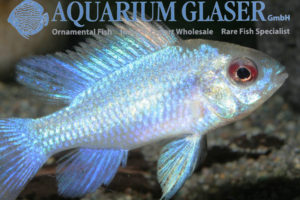
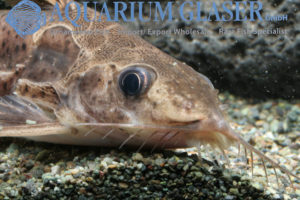
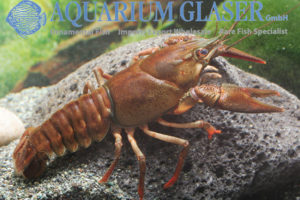
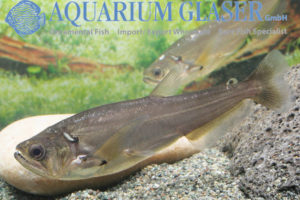
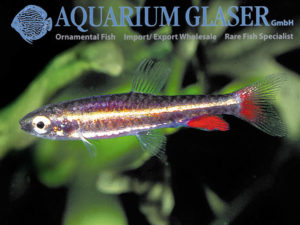
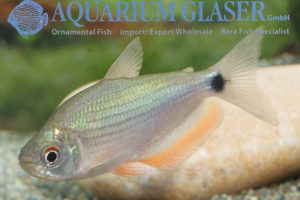

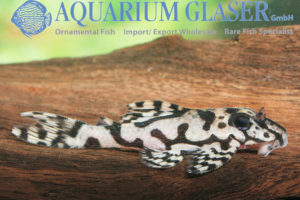
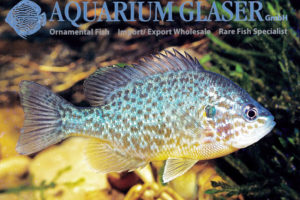
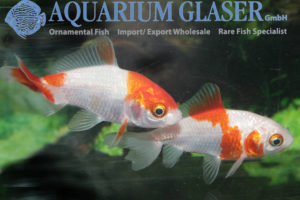
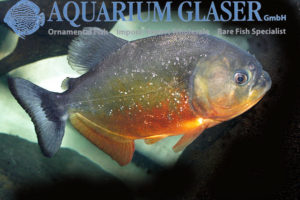
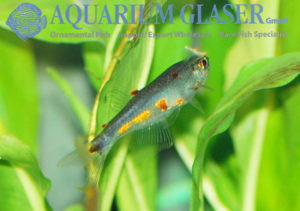
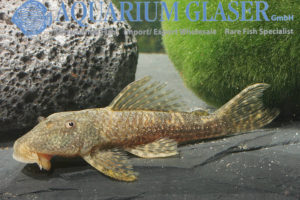
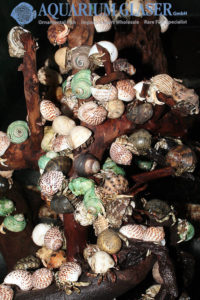
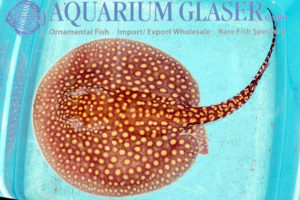
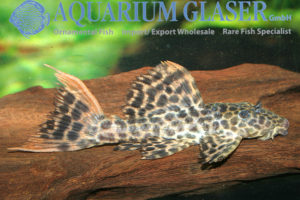
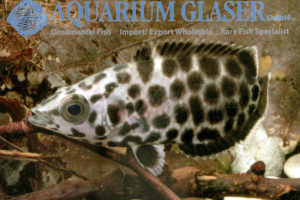
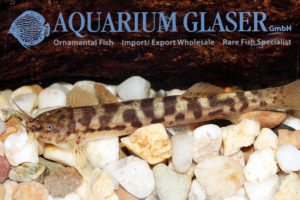
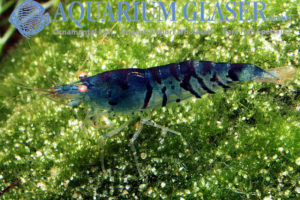
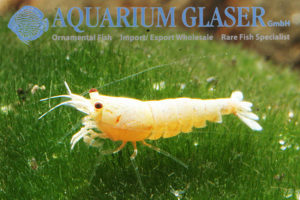
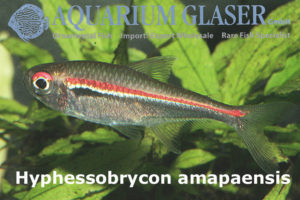
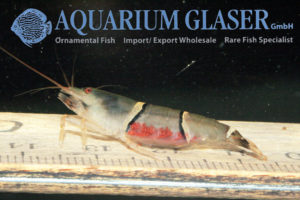
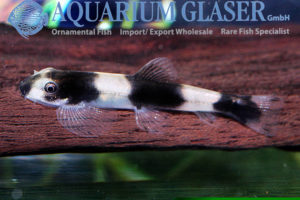
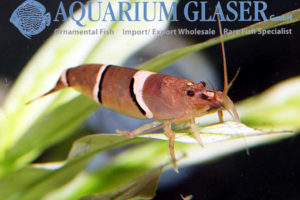
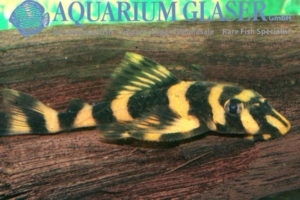
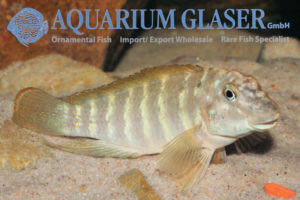
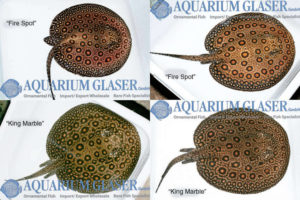
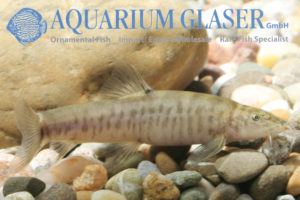
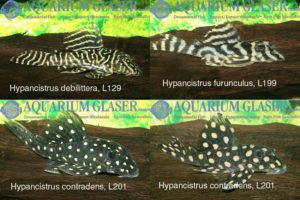
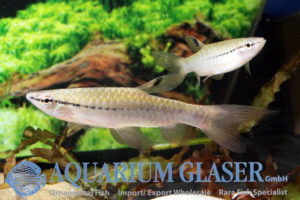
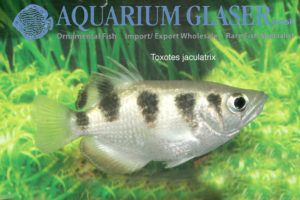
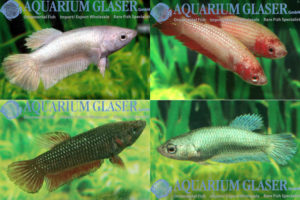
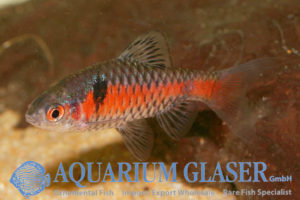
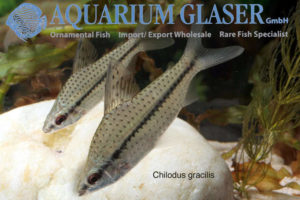
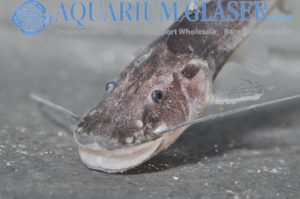
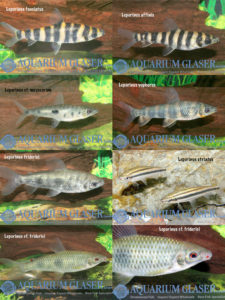
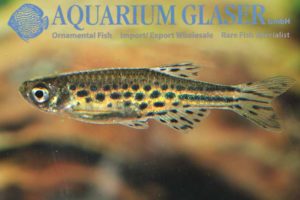
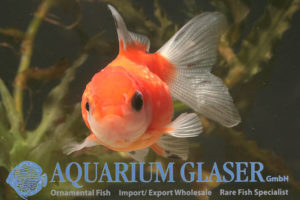
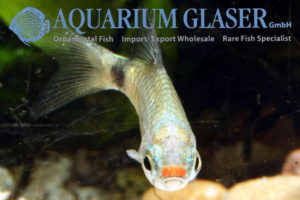
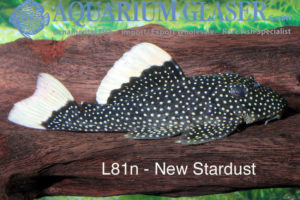
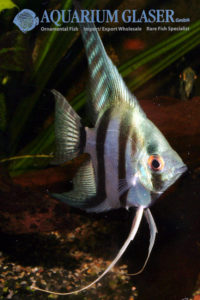
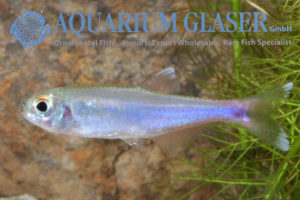
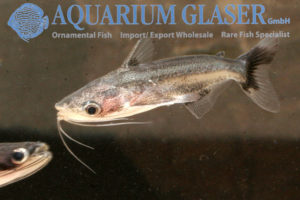
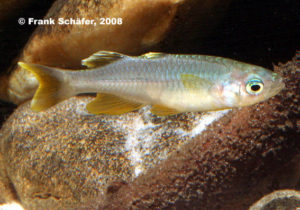
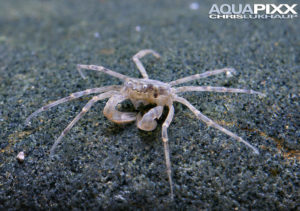
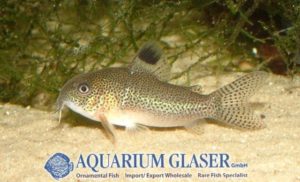
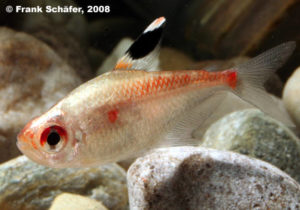
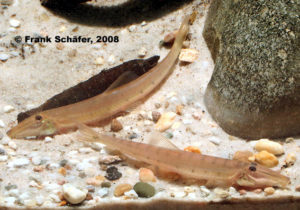
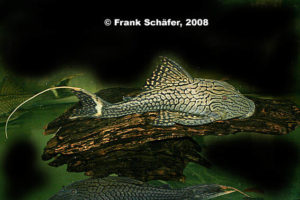
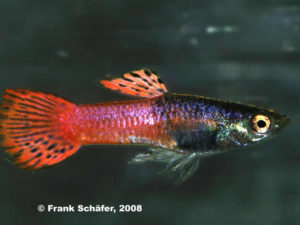
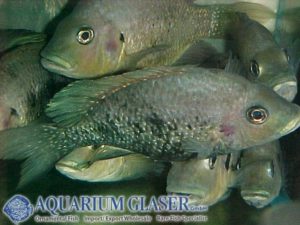
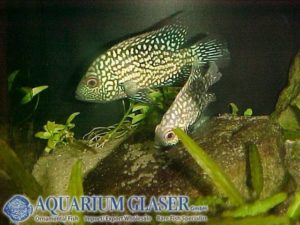
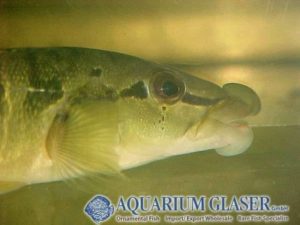
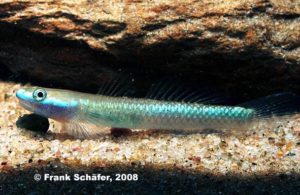
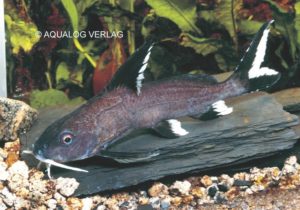
-300x225.jpg)
